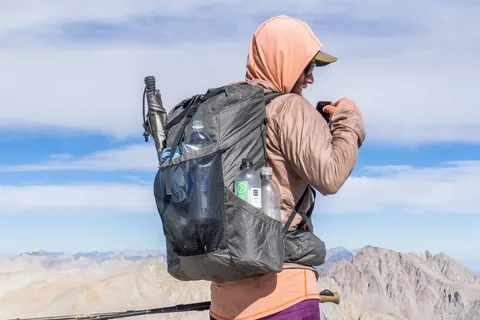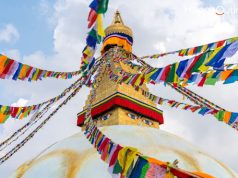1) Mt. Everest Base Camp (EBC) Trek, this is the most notorious trek on earth to the base camp of mt. Everest. You will be walking through the heart of the Himalayas and have some of the most amazing views of the world’s highest mountain, Mount Everest, and you can also experience the Sherpa culture. However, the fact is, this high-altitude hike can be superbly brutal for your frame. What’s one of the fundamental things you need to deal with? Your backpack load. The result is pain, fatigue, and perhaps injuries that will shift your focus away from the rest of your trip.
It’s All About Packing! In Front-Line Packing Efficiency is all about packing light AND packing so that you have with you everything you need to do great things on the trek! Not onlywill yy will you not going to be so painful for your body, you will be able to save some energy, acclimate to the altitude, and also indulge a little bit more in what should be the trip of your life!
Why Take The Right Backpack Weight for EBC Trek
Everest Base Camp Tour requires walking hour of trek for a day and walking on rocky, uneven paths. But nothing is worse than schlepping an overstuffed backpack that is prohibitively heavy. And the more extra weight you have to bear all day long, the more strain it can place on the body, and how tired you may feel, not to mention the risk of straining and injuring yourself. That is extra crucial at higher altitudes, as your body is already making more effort to conform to the lower concentration of oxygen.
The effect of an oversized backpack is particularly pronounced above 00m, as even a minor project will become a burden for the frame. The less weight to your again, the greater strength you may have left to take on the trek. In case you’re not carrying a variety of load, you’re quicker and extra on stability, so that could be pretty beneficial around some of the trickier parts of the song.
What to take with you: packing tips for the EBC trek
What to pack for the Everest Base Camp Hike is sometimes a pain in the ass, especially for the starters. And a few straightforward tips can help you shave that pack weight without compromising comfort or safety.
Stick to the Essentials
The number 1 rule of packing for the EBC trek is to keep things simple. It’s tempting to want to bring all those “just in case” pieces of gear, but that’s how you end up with an overstuffed backpack. Only carry the things you’ll use on the trek! This includes:
Clothing You will have to get some form of thermal clothing: ■ Ski socks: one, or better, two pairs. The two necessary ingredients for a layer game under a waterproof top layer are a moisture-wicking base and an insulating midlayer.
Trekking Equipmentlightweight trekking boots, peak cap, hand gloves, a pair of r, headlight, and trekking Pole. Bring only what has practical use.
Sleeping: You’ll want to pick up a thin down sleeping bag, and a thin sleeping pad too. Nights can get cold at higher elevations; however, streamlining what you p.c. doesn’t mean giving up the warm temperature you want.
Take a 2nd to pause and determine your tools earlier than you start stuffing it, cramming it, or whatever different makes-it-paintings method you come up with; the whole lot for your PC. It must be something that will help you through the trek.
Invest in Lightweight Gear
Your chosen gear will also have a massive impact on the weight of your backpack. It’s a marquee, and it’s something to consider before moving in,o but I would maybe also investigate trekking gear. Here’s what to focus on:
Backpack LETS CARRY A You need a 40-50 liter backpack, preferably lightweight weight for the trek. It should be heavy duty, have good balance,, have a comfortable feel in the hand for all-day use.
Sleeping Bag: For high altitude travel, down sleeping bags are preferable to synthetic sleeping bags as they are warmer, lighter, and compressible, thus fill power; so you must bring the good one. Be sure the bag is cold-weather rated, as nights can get cold.
Clothing: Layer up – with first a close-fitting base layer, ideally one that wicks moisture away from your skin, then mid-layers that offer warmth, and a final layer you can trust won’t let in bad weather. Don’t bring thick clothes that just take up space and don’t keep you warm and dry.
Since, of course, Light, high-quality gear can help you shave pounds from your backpacking setup without sacrificing comfort or safety.
Layering for Weather Flexibility
The EBC trek weather is kind of unpredictable, and is generally sunny, but nights are cold for sure, and might contain snow. For this kind of stretch, a layering system is your friend:
Base Layer: A moisture-wicking base layer enables regulating frame temperature and wicks moisture far from your frame, which is especially vital at high elevations.
Mid-Layer: Fleece or insulation jacket. Good for insulation, and shouldn’t dominate much space in your pack.
What to carry with you outside: bring along a lightweight, waterproof jacket and pants to shield yourself from wind and rain, or snow.
As the temperature changes throughout the season, you can react with the appropriate selection of layers! That said, you won’t have any issues layering up on the trail or stripping down to your base layer when the temperature rises. It also stops you from over-packing bulky clothes you likely won’t need, and are heavy to boot!
Renting Gear Locally
You don’t need to take everything with you. There are lots of things you can rent in Kathmandu or Lukla, which can help you save on weight and space.. Lesser-known things you can rent:
You will want to buy or hire one there. Down Jacket – In Kathmandu, they have places to hire, but I would buy one. You are best off renting one, and then you don’t have to pack such a big pack up to Everest Base Camp.
Sleeping Bags: You can hire high-altitude sleeping bags. Which should cut down on your odds of getting stuck with a tent-size sleeping bag.
Pole You SHOULD rent (at the very least) or borrow poles if you don’t have them already. They’re nice to have when the path gets steep and you require balance.
You can still be ready for the journey and lighten your backpack by renting them on-site.
Hydration and Snacks
And you need hydration and sustenance to keep you going as you hike. But that does not mean that you should bring extra food and water. Here’s how to stay efficient:
Hydration Bladders: The Hydration bladders are great as they are fairly easy to use, practical, and easy to use, so they can stay hydrated. Andyeahh thanks to two water bottles, specific/individual 1 Liteh. The majority of the teahouses provide refills of water as you go, so you can always make a fill-up.
HIGH Front-Line: The Weight-to-pack ratio for their Epic EBC-Trek.
Lightened the backpack: This is what you need to do if you want to do the Everest Base Camp trek. Here are a few tips on how to lighten your load (beyond the obvious of only bringing exactly what you need, investing in the latest and greatest lightweight technology, seeing how you can slim down in the organization department of the pack, and renting locally – but of course). Less weight in your pack, less energy, less fatigue, and MORE FUN hiking one of the most beautiful places on earth.
This isn’t to say you should lug around less, necessarily, but carry smart. The EBC Trek, like any hike, is only as easy or difficult as you want to make it.









